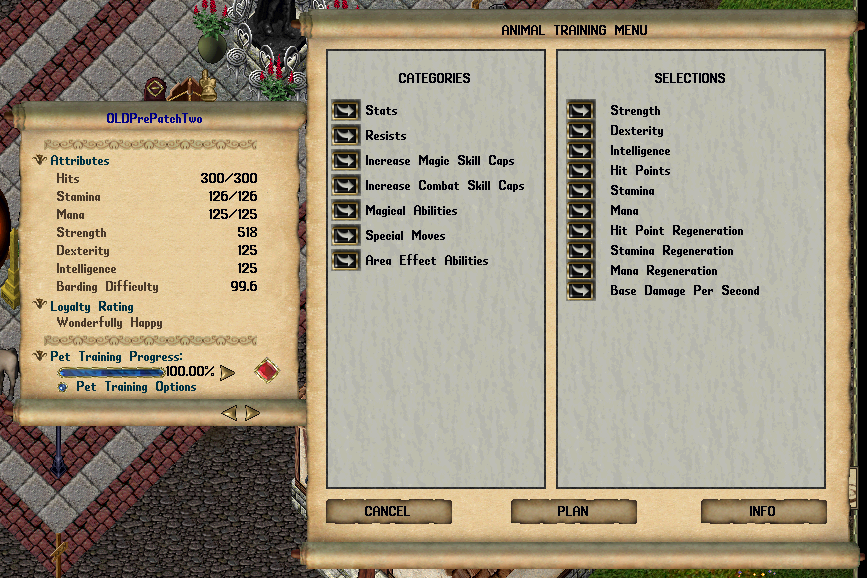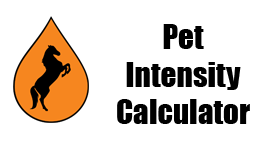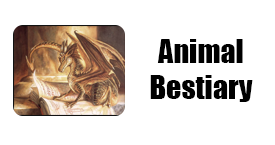Pet Training 101: Pet Training Basics
This guide is designed to help you get a basic understanding of what makes a good pet, and how to be successful in applying training points to your pets.
This guide will not cover specific pet builds, but rather a general purpose guide you can follow to make a successful pet.
If your pet is not ready to begin applying training points, please see the first article in the series: Beginning Animal Training
We also strongly recommend that you enter your pet into our Pet Planner Tool and play around with adding points to the pet before you apply any training in-game. This will give you an idea of how points are applied, and what your pet will be capable of once fully trained.
Animal Training Menu
To begin applying points, use Animal Lore on your pet your pet and click the blue dot at the bottom of the window for "Pet Training Options". This will open up the Animal Training Menu. From this menu, you can look at available abilities, increase stats and resists, and apply powerscrolls to your pet.
** IMPORTANT NOTE **
Once you apply Training Points to your pet, they cannot be undone!
Make sure you pay attention to how you are applying points to your pet.

Training Priority Order
Training a pet can be overwhelming at first, with a lot of available options. There is a general order in which you want to apply training to your pet to be the most efficient:
Resists
Resists will help your pet stay alive longer, making all future levels of training much easier. Resists are also extremely important for all content in the game, as they reduce the amount of damage your pet takes.
Resists have a cap of 365 Total Resists across all 5 resists. This means you cannot have 80 in every resist, so make sure you plan out carefully how many of each resist you want, otherwise you may end up with an undesirable resist spread.
Some pets start with overcapped resists (such as Cu Sidhe's that can have up to 85 in Cold and Energy, or Tritons that can have up to 90 in Energy). Make sure you take this into account when you plan your resists.
Some common resist templates are:
- 80 Physical / 75 Fire / 70 Cold / 70 Poison / 70 Energy
- This is a well-rounded proven effective resist template for your pet. This allows you to take your pet to any content in the game without having to worry about your pet being weak to anything in particular. Physical and Fire damage are the 2 most common damage types, so those are given a higher distribution.
- This is a well-rounded proven effective resist template for your pet. This allows you to take your pet to any content in the game without having to worry about your pet being weak to anything in particular. Physical and Fire damage are the 2 most common damage types, so those are given a higher distribution.
- 80 Physical / 80 Fire / 70 (65) Cold / 70 (65) Poison / 70 Energy
- This is a slight variation of the above well-rounded resist template. It adds 5 extra resists into Fire, and you typically takes 5 points of resists out of Cold and/or Poison resists.
- This is a slight variation of the above well-rounded resist template. It adds 5 extra resists into Fire, and you typically takes 5 points of resists out of Cold and/or Poison resists.
- 80 Physical / 80 Fire / 65 Cold / 65 Poison / 75 Energy
- Another slight variation of a well-rounded resist template. This time also adding an additional 5 Energy resist (the third most common damage type).
Stamina & Dexterity
Companion Article: Foundations: Stamina & Foundations: Dexterity
The next training priority should be Stamina and Dexterity. Stamina controls the speed at which your pet attacks, and Dexterity controls the speed at which your pet moves.
Settings Stamina to 150 will allow your pet to attack at max swing speed, which is very important for maintaining pet damage, and setting Dexterity to 150 will allow your pet to move and follow at (near) max movement speed (the Dexterity cap is actually 190, but you can only achieve this with naturally overcapped pets).
Base Damage
Companion Article: Foundations: Base Damage
Base Damage is actually going to be the #1 most important stat you increase on your pet; however, it is a unique stat as it is the only stat in which the cap will increase depending on the current control slot of the pet.
This means that you must apply Base Damage training in the final round of training!
You can apply Base Damage training at earlier stages as well, this will not lose you points. But you must make sure you increase your pet's Base Damage to the capped value when you are doing the final round of training.
Max Base Damage will appear in the Training Window as "Base Damage Per Second 22", with a training cost of 110/110.
Max Base Damage will appear on your pet's lore window as 24-33 Base Damage.
Hit Point Regeneration
Companion Article: Foundations: Hit Point Regeneration
Many players skip HPR on their pets, but it is an incredibly useful stat. Please see the companion article for a more in-depth look at why HPR is important, and can actually be more efficient than high Health.
You typically want at least 10 HPR on your pet, and if it has the points available, 20 HPR by the last round of training.
Mana Regeneration
Companion Article: Pet Mana Regen Calculator
Mana Regeneration is critical for your pet. Every action (other than a standard basic attack) your pet does, requires mana. When your pet runs out of mana, your pet is doing significantly less damage. You want to set this to 30 by the last round of training to ensure your pet is regenerating enough mana.
Strength
Strength is a critical component in the damage calculation formula for your pet. The more Strength you have, the more damage your pet will do. Trainable Strength is capped at 700 and you want to hit this number by the final round of training on your pet.
Note: There is a total attribute limit shared between Strength, Dexterity, and Intelligence. If your pet starts with Overcapped Intelligence (370+) and/or Dexterity (150+), then you will not be able to reach 700 Strength. This is OK, just get as much Strength as you can. (This is common on pets like Fire Beetles and Giant Beetles).
Intelligence
Companion Article: Foundations: Intelligence & Pet Mana Regen Calculator
Intelligence is often ignored by tamers and it is unfortunate, as Intelligence plays a major role in the Mana Recovery Formula for your pet (combined with Mana Regeneration). As mentioned above, Mana Recovery is critical for your pet to sustain its damage throughout a fight.
Since there is a total attribute limit, Intelligence will be capped at being trained to 370, assuming your pet has 150 Dexterity and 700 Strength. Make sure you invest into Intelligence for your pet, is it very useful!
Players often forego Intelligence in order to save training points, however, Intelligence is so efficient in the Mana Recovery Formula, that it would actually be better to always go 370 Intelligence and instead save training points by having lower Mana Regeneration (such as 20 or 15). Ideally though, you want 370 Intelligence and 30 Mana Regeneration on your pet.
Stamina Regeneration
Stamina Regeneration helps your pet keep its Stamina level high, which means it can continue to swing at max attack speed. Most pets will want at least 10 Stamina Regeneration (5 is acceptable if the build is going to be fairly tight). This can be done in the last training round if necessary.
Hit Points & Mana
Yes, Hit Points and Mana are really this far down on the priority list. Often players will give these the highest priority, which will leave them short on points for more critical stats later on.
With Hit Points and Mana, you should have a "target" value in mind, and then in the last round of training, once everything else is done to your pet that you want to do (including Abilities and Power Scrolls), you finish the pet off by adding more Hit Points and/or Mana.
A target of around 400-500 mana is a good pool of mana for most pets.
Hit Points are highly subjective and it will depend what you are comfortable with. We often target around 400-500 Hit Points on our pets, but a lot of tamers don't feel comfortable with less than 600-700 Hit Points. The main idea behind lesser health is that your pet shouldn't be taking over 500 points of damage without receiving some kind of support from you (or your group).
Nothing will 1-shot your pet with 400 health, so as long as you are supporting your pet with heals/consume, you shouldn't need to worry about having over 600 health on your pet.
If your pet has low starting health, you can move Hit Points to a higher priority in training in order to make it easier to train the pet (such as setting hits to ~400 or so to start).
Hit Points and Mana should be used as filler to finish a level, or after all other training is complete.
Magicals, Abilities, Powerscrolls
Companion Article: Pet Planner & Pet Scroll Cost Calculator
These aren't necessarily the lowest priority, but these are very dependent on the type of pet your are creating. Often you will not add Powerscrolls until the last round of training, but make sure you plan out your pet properly so you are not short on points for applying Powerscrolls, Magicals, or Abilities.
Summary
- Plan Your Pet Before Applying Training Points
- Knowing what each stat does and why you are applying it will help greatly in understanding pet training
- Prioritize Important Stats over Less-Important Stats
- Note: You can add some Hit Points during the first round of training for better sustainability if your pet has low starting health
- Ensure you have enough points saved for your Magicals, Abilities, and Powerscrolls (refer to your plan!)
- Always Max Base Damage in the last round of training!

